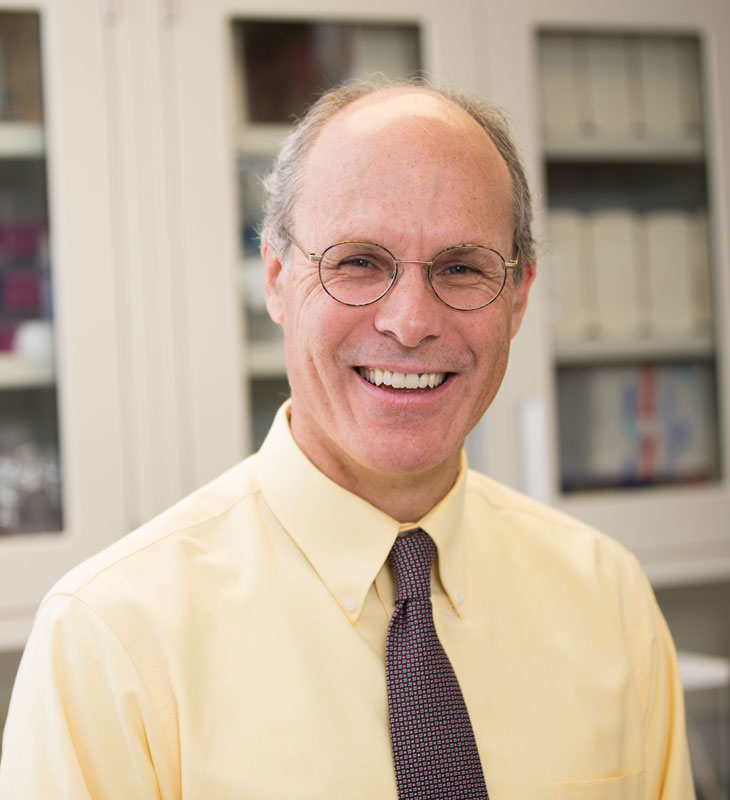
Vet Med Faces of Research: Dr. Myron Hinsdale
Tuesday, January 4, 2022
Myron Hinsdale, Ph.D., has been conducting research for nearly 25 years.
An associate professor in the Department of Physiological Sciences at Oklahoma State University’s College of Veterinary Medicine, Hinsdale focuses on proteins. He uses a swimming pool analogy to explain exactly what that entails.
“If you think about a swimming pool with inner tubes floating in the water, the tubes represent cells in the body,” he said. “The water represents the fluid in the body that buoys the cells, it disperses the cells and moves the cells. That fluid affects how the inner tubes/cells behave. In my lab, we study the proteins in that fluid. How they control the cells, move the cells, stimulate the cells to divide and proliferate and what kind of cells they may become when they grow up.
“Most of my research is geared toward human disease; however, there is always a direction that leans toward veterinary diseases because a number of diseases are so common between species. So with both humans and animals, the cells that float in this fluid can be affected by inflammation, infection or genetic disorders. Those are the main things we focus on when we’re looking at diseases in humans which can be applicable to animals.”
Currently Hinsdale’s lab studies three areas — polycystic kidney disease, fat metabolism and the lung.
“Polycystic kidney disease is a common genetic disorder due to mutations in three genes in humans. The disease affects the kidneys and the liver. It causes kidney failure but it also causes enlargement of the liver resulting in fibrosis. Fibrosis is in the fluid I mentioned earlier and changes the types of cells that grow there. As a result, the cells become scar tissue rather than functional liver cells.
“How the body maintains different areas of fat in the body seems to be related to stem cells. How those stem cells behave and how they are cued to proliferate to develop from a stem cell into a fat cell are what we are studying. We’ve discovered several different proteins that are important for cells to move from a stem cell to a mature, white fat tissue cell.
“Lastly, we’re looking at how infectious disease affects that same fluid that surrounds and supports the cells in the lung and how it affects lung function.”
Hinsdale finds several aspects of research exciting.
“Selfishly what’s exciting about my research is that momentarily I know something that no one else knows. You’re able to think your own thoughts, conceive your own ideas and move forward with that. But overall, I think understanding the biology, how the chemistry works and the complexity of all that is just a peek underneath the cover so to speak and that’s exciting.
“Working with graduate students is also rewarding. Watching them develop and grow as researchers and seeing the lights come on when they get it. It’s important that students follow their passion in what they do. Because once they start on that journey, it gets exciting but it also gets unexciting. Getting through those valleys is where the passion kicks in and drives you over that bridge to the next mountain. So understanding what they’re interested in — the biology, the chemistry, the disease — whatever it is that drives them is important.
“I view success in the lab on several different levels. On a daily basis, success would be getting a certain assay to work that’s been hard. It’s not like opening a cookbook and doing a process/recipe in the lab. It takes refinement, a lot of thought and troubleshooting. Getting that result and sometimes not getting the result you want but getting a black and white result, a clean result, is important and that’s success on a daily scale. Long-term success is publishing your work, getting it accepted by your peers, which can be frustrating. Also getting recognized through support and grants. And lastly, talking to people and encouraging them to be curious, to ask questions so that they understand what science and the research is about.
“The one thing I think is important is telling people about my research and having them understand what it means. I hope it encourages people’s faith in science. We’re not just some crazy person doing weird things in a lab. There is a direction to it. At the surface, it may not seem like it and while these studies may not lead to a cure or a diagnostic test tomorrow, it is a step in the process. Sometimes it’s a bound and sometimes it’s just a step. So understanding the concept of science is important. Understanding that there are so many things in biology, chemistry and medicine that we don’t understand and through research we can begin to comprehend is wonderful. In our studies, we can impact many different types of diseases due to the effects the fluid has on cells and that’s exciting.”
Hinsdale completed his doctorate at the University of Alabama-Birmingham School of Medicine followed by a post-doc at the University of North Carolina-Chapel Hill Medical School in the laboratory of Nobel Laureate Oliver Smithies. He has been on faculty at OSU’s veterinary college since 2007. In addition to research, he teaches several courses in the first year veterinary curriculum.
Vet Med Faces of Research is a monthly series designed to inform the public about the impact of the numerous studies being conducted at Oklahoma State University’s College of Veterinary Medicine. Advancing knowledge and understanding for the benefit of the lives and livelihoods of the people of Oklahoma is a critical element of OSU’s land-grant mission. If you would like to support research at the college, please contact Ashley Hesser, director of development with the OSU Foundation, at 405-385-0715 or ahesser@osugiving.com.
